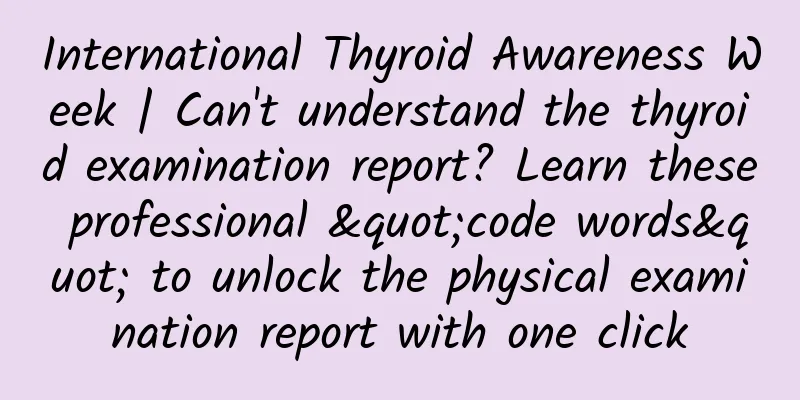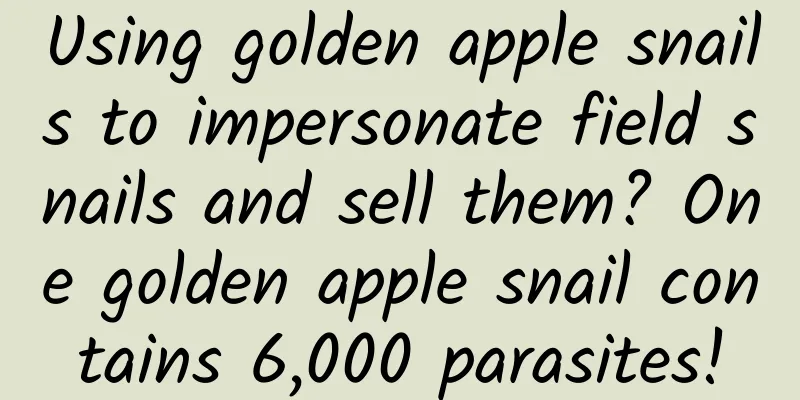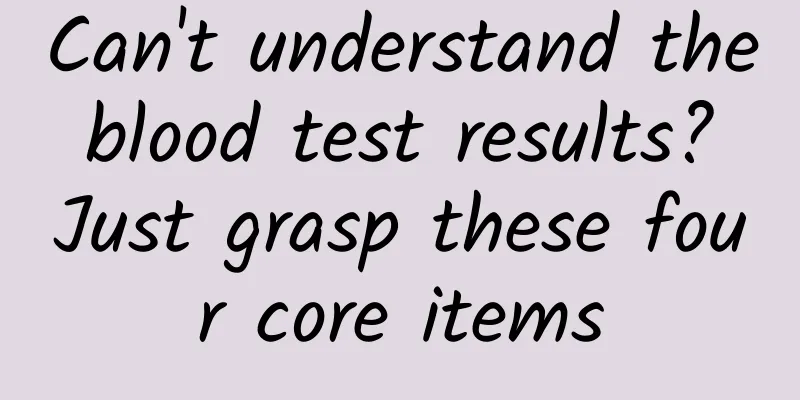International Thyroid Awareness Week | Can't understand the thyroid examination report? Learn these professional "code words" to unlock the physical examination report with one click

|
The incidence rate increased 20 times in 16 years In recent years, young women are more favored It's thyroid cancer. Don’t be lazy if you are lazy! I heard that regular physical examinations can keep you away from this "killer" But physical examination is a trivial matter Not understanding the medical examination report is a big problem Heterogeneous echogenicity? Nodularity? TI-RADS 4A? … A bunch of terms that make people confused don’t worry Today, Fat Bear invited an expert from the Department of Thyroid Oncology Decipher the medical examination report for everyone step by step Benign or malignant? Thyroid ultrasound can be used to determine The thyroid gland is the largest endocrine organ in the human body. It is shaped like a butterfly and consists of the left lobe, right lobe and isthmus. The thyroid gland plays an important role in the body's metabolism, growth and development, increasing the excitability of the nervous system and cardiovascular system, and affecting the digestion and absorption of gastrointestinal function. Thyroid nodules and thyroid cancer are common thyroid diseases. Thyroid nodules refer to lesions caused by the abnormal growth of thyroid cells in the local area, which are mass-like changes inside the thyroid gland. Thyroid nodules are divided into benign nodules and malignant nodules. Malignant nodules are what we often call thyroid cancer. The thyroid color ultrasound TI-RADS in the physical examination report will score and grade the nodule based on its specific morphology to determine whether it is benign or malignant. There are also different responses for different levels. TI-RADS classification Category 1: Normal thyroid gland, no lesions, risk of malignancy is 0. Category 2: Diagnosable benign thyroid nodules with a malignancy risk of 0. Long-term (12-month) follow-up is clinically recommended. Category 3: Benign, potentially larger thyroid nodules with a malignancy risk ≤ 3%. Clinically, medium- to long-term (6-month) follow-up is recommended. Category 4A: Thyroid nodules with a certain possibility of malignancy, with a malignancy risk between 3% and 30%. Clinically, short-term (3-month) interval follow-up is recommended as the first choice; fine needle aspiration biopsy is the second choice; if the biopsy result is negative, continue short-term follow-up. Category 4B: Thyroid nodules with a high potential for malignancy, with a malignancy risk between 31% and 60%. Fine needle aspiration biopsy is clinically recommended as the first choice; if the biopsy result is negative, the puncture can be repeated at short intervals, or surgical treatment can be considered. Category 4C: Thyroid nodules with a high potential for malignancy, with a malignancy risk between 61% and 95%. The clinical recommendation is surgical treatment as the first choice; fine needle aspiration biopsy followed by surgical treatment is the second choice. Category 5: Diagnosable malignant thyroid nodules, with a malignancy risk of >94%, and immediate surgical treatment is clinically recommended. Category 6: Malignant nodules confirmed by pathology. The vast majority of thyroid nodules are benign, but those with malignant potential should not be ignored. This type of thyroid nodules requires dynamic observation and follow-up. Thyroid nodules that require surgery include: 01 Benign nodules larger than 4 cm or with compression symptoms; 02 Patients with thyroid nodule fine needle aspiration showing cancer, especially those with malignancy indicated by puncture cytology, or BRAF gene mutation in genetic examination; 03 Fine needle aspiration did not indicate cancer, but imaging examination showed that the nodule increased by 20% in a short period of time. Emotions or genetics? Pathogenesis is related to emotions In recent years, with the popularization of color Doppler ultrasound examinations and the improvement of people's awareness of health examinations, the incidence of thyroid cancer in China has continued to rise, showing a trend of rapid growth. According to the latest cancer report released by the National Cancer Center in 2022, from 2000 to 2016, the incidence of thyroid cancer in China has increased year by year, increasing 20 times in 16 years, and has become the seventh most common cancer in China. It is worth noting that thyroid cancer ranks at the forefront of the rising incidence trend among women. The increase in incidence is largely due to two factors: first, thyroid nodule disease is an age-related disease; second, current population surveys show that life expectancy in most industrial countries is increasing. These two factors have led to an absolute increase in the incidence of thyroid nodules. The incidence of thyroid nodules is related to age, gender, nature of work, mood, etc. In the age group of 30-49, work pressure, mental state, hormone levels, etc. are at a higher stage in life, which is one of the reasons for the higher incidence of thyroid nodules in this age group. Studies have shown that it is associated with the following risk factors: Gender and age: Relatively speaking, the probability of women suffering from thyroid cancer is higher than that of men, and female patients are about 2 to 4 times that of male patients. In terms of age, thyroid cancer can occur at any age, but the most common age for women is 40-50 years old, while for men it is 60-70 years old. Genetic factors: Certain genetic traits may be associated with specific types of thyroid cancer, so that they run in families. If a first-degree relative (a parent, child, or sibling) has thyroid cancer, your risk of developing thyroid cancer is increased. Radiation history: Exposure to radiation (both medical and nuclear) has been shown to be a clear risk factor for thyroid cancer. Whether the head and neck are exposed to radiation during childhood is particularly critical. Overweight and obesity: People who are overweight or obese have a higher risk of thyroid cancer than people of normal weight. Gentle or dangerous? "Lazy cancer" should not be taken lightly According to the type of tissue cells from which thyroid cancer originates, it is pathologically divided into four types : papillary carcinoma, follicular carcinoma, medullary carcinoma, and undifferentiated carcinoma . Papillary carcinoma and follicular carcinoma account for about 90% of thyroid cancers. Because thyroid cancer presents "two lows and one good" (mostly low malignancy, low mortality, and good prognosis ) and is easy to detect early, it is often called "lazy cancer." But "lazy cancer" is not all gentle, it also has a dangerous side. If we take it lightly and let it develop, it will cause irreversible consequences. We are not short of such actual cases in clinical practice. When the thyroid cancer mass grows, it can be palpated in the front of the neck, on one side or both sides of the trachea. At the same time, the enlarged mass presses the trachea backwards, causing chest tightness and dyspnea; compresses the esophagus, causing dysphagia; compresses the recurrent laryngeal nerve, causing hoarseness, etc. When thyroid cancer invades the trachea, it can cause hemoptysis in patients. First of all, thyroid cancer is still "cancer", and if it is cancer, it is a major disease and poses a serious threat to life and health. Secondly, among thyroid cancers, only papillary carcinoma progresses relatively slowly, but that does not mean it does not progress. The other three types of cancer do not progress slowly. If left untreated, they will progress very rapidly once they reach the middle or late stages. In addition, the prognosis of different thyroid cancer subtypes is also different. The 5-year survival rate of some middle or late stages is less than 50%. Finally, clinical examinations have found that some microcancers may also have lymph node metastasis or distant metastasis, which does not mean that microcancers are early cancers. This requires special attention to the TI-RADS classification of color Doppler ultrasound examinations. 01 Early prevention Doing these things can effectively reduce the risk Although some of the reasons for the increase in the incidence of thyroid cancer are still unclear, according to the existing data, the onset of thyroid nodules is mainly physiological and pathological, and is related to factors such as excessive iodine, iodine deficiency, high fluorine, increased thyroid hormone requirements, radiation, age, gender, mental state, nature of work, and emotional changes . Therefore, paying attention to some matters in our daily lives can effectively reduce the risk of cancer. Avoid excessive radiation exposure Especially children and teenagers. Proper diet: Eat a balanced amount of fruits, vegetables and meat, especially iodine. Exercise at least 3 times a week: Studies have confirmed that exercise can regulate hormone secretion levels in the body and prevent hormone-related cancers. Adjust your mood: Scientific research has found that negative emotions such as sensitivity, suspicion, anger, tension and anxiety are closely related to the occurrence of cancer. These emotions can easily lead to endocrine dysfunction and decreased immunity, which in turn leads to various physiological disorders in the body and causes cancer. Avoid excessive drinking: The International Agency for Research on Cancer has classified alcohol and its primary metabolites as Class 1 carcinogens, with the highest level of evidence of carcinogenicity in both human and animal experiments. Physical examination to screen for tumors: Tumor screening is an important way to detect cancer and precancerous lesions early, especially for high-risk groups such as those with a family history of tumors, a history of long-term exposure to carcinogenic factors, long-term bad living habits, and long-term malnutrition. Especially those over 45 years old should pay special attention to tumor screening and have regular physical examinations. 02 Early detection Self-examination + color Doppler ultrasound is the preferred method There may be no symptoms in the early stages of thyroid cancer, and the patient may not feel any discomfort, so early detection, early diagnosis, and early treatment are particularly important for thyroid cancer clinically. Self-Test First, tilt your neck back and raise it, and look in the mirror to see if your thyroid gland is enlarged and symmetrical on both sides. Second, while swallowing, touch your neck from top to bottom and then from bottom to top to see if you can feel any bulges or lumps. Screening If you feel a lump, it is recommended to go to the hospital for examination in time. Of course, if you are in the high-risk group mentioned above, it is recommended to have regular physical examinations. Ultrasound examination: Color Doppler ultrasound examination uses TI-RADS classification based on indicators such as the substantiality, low echo, significant low echo, microlobulation or unclear margins, microcalcification, and longitudinal diameter of the thyroid nodules to further evaluate the benign or malignant nature of the thyroid nodules. Thyroid fine needle aspiration (FNA): It uses a fine needle to obtain a small amount of tumor cells from the thyroid nodule for pathological analysis to determine whether the thyroid mass is benign or malignant. It plays an important role in the preoperative diagnosis of thyroid cancer. CT or MRI (magnetic resonance imaging): MRI (magnetic resonance imaging) and CT are not used as routine examinations for thyroid nodules unless the patient's tumor is large, breaks through the capsule, has obvious lateral cervical lymph node metastasis, and the relationship between the primary lesion or metastasis and the surrounding anatomical structure is unclear. They are mainly used to understand the relationship between thyroid cancer and surrounding tissues and organs. Thyroid radionuclide examination: ① Determine the size, shape, and location of the thyroid gland; ② Identify the nature of the neck mass and look for thyroid cancer metastases; ③ Determine the amount of surgical resection and estimate the therapeutic dose of radioactive iodine-131 based on the volume and weight of the patient's thyroid gland; ④ Observe the morphology of residual thyroid tissue after surgery, etc. Thyroid function tests: Thyroid function test is commonly known as thyroid function in clinical practice. It is done by drawing venous blood and testing a series of thyroid-related hormones and proteins in the blood. The levels of these hormones and proteins can be used to indirectly understand whether the thyroid gland is healthy. Depending on your needs and the purpose of the examination, your doctor will choose to check all or part of these indicators. 03 Early treatment Listen to the doctor's advice and choose the best solution Most benign thyroid nodules do not require special treatment, only regular follow-up observation. In a few cases, surgery, radioactive iodine therapy, TSH suppression therapy, ablation or other treatment methods can be selected. Malignant thyroid nodules, i.e. thyroid cancer, are mainly treated with surgery, followed by TSH suppression therapy after surgery, and then radioactive iodine therapy is selected according to the situation, and follow-up observation after surgery is carried out. However, different patients have different situations and demands. Therefore, doctors generally develop personalized treatment plans based on the patient's situation. For example, patients who are concerned about postoperative scars and have cosmetic requirements can undergo laparoscopic thyroid surgery if they meet the indications. Some patients who do not need surgical treatment but are very concerned about thyroid nodules can consider thyroid ablation. Therefore, when thyroid nodules or thyroid cancer are detected, you can listen to the doctor's advice and choose the treatment method that best suits you based on your own situation. Postoperative care: After surgery, patients with thyroid tumors need to keep the wound area clean and dry to avoid infection. After the stitches are removed and the wound heals well, they can take a bath normally. At the same time, pay attention to whether there is numbness or muscle cramps on the face, around the lips, hands and feet. In mild cases, oral calcium can be taken. In severe cases, you need to inform the doctor in time and follow the doctor's advice. If there is no discomfort on the first day after surgery, you can do simple head raising and nodding movements; on the 2nd to 3rd day, you can move your neck slightly up and down, left and right, and avoid turning your head significantly; after the stitches are removed, start to insist on neck and shoulder function exercises for 3-6 months. At the same time, you can carry out general daily activities after surgery, and you can exercise appropriately, but avoid strenuous exercise. Diet: After surgery, patients can eat less seafood, such as kelp, because these products are rich in iodine. There are no other special taboos. The food temperature should not be too cold or too hot to reduce the stimulation to the thyroid gland. High-nutrition, high-fiber foods should be consumed daily. Vegetables, fruits, eggs and dairy foods should be the main foods. Greasy, spicy, irritating, raw and cold foods should be avoided. Smoking and drinking should be stopped. After discharge, patients need to go to the hospital for reexamination as directed by the doctor, have blood drawn for testing, and check thyroid function and thyroid ultrasound, etc. Check yourself regularly, and if you find nodules or lumps, you should treat them in time. |
>>: This image ended the 170-year debate about ice丨Expo Daily
Recommend
How much carbon can a tree store? Different trees have different abilities
When it comes to reducing carbon emissions, we al...
Analysis of Xiaohongshu’s category operations!
I have been dissecting Xiaohongshu accounts recen...
Vanishing birdsong: How to track the impact of climate change on the region's soundscape?
The International Department of the China Biodive...
Fitness Advanced【Precision】Precision Back
Fitness Advanced [Precision] Precision Back Resou...
How to set up the Douyin Super Lucky Bag? How to set up Douyin Super Lucky Bag
Tik Tok has introduced a new way of playing: luck...
Baidu launches smart mini-programs, which industries will benefit from it?
When it comes to mini programs , Baidu, which sta...
"Po", "Min", "Benzene"... Do you know what these words in medicine names mean?
|||| Written by reporter Wang Xueying, Photo and ...
Will the strongest gamma-ray burst reveal these supernova "explosive materials"?
"We are in awe and feel very lucky to be abl...
Which specific reports should I look at to analyze Baidu bidding account data?
Recently, I have often come into contact with som...
The garlic I ate yesterday still smells today! I heard that drinking yogurt can get rid of the garlic smell immediately?
As the saying goes, "If you eat meat without...
How to quickly increase fans on Kuaishou? What should I pay attention to when increasing followers?
This article mainly introduces how to quickly inc...
IDC: AI-driven smartphone spending will reach $32 billion in 2028
IDC's 2025 Asia Pacific (excluding Japan) cus...
Clothes that are dried in the shade smell bad... See here for quick deodorization methods →
Review expert: Peng Guoqiu, deputy chief physicia...
Fire protection maintenance technical service mini program function, how much does it cost to develop a WeChat fire protection mini program?
Fire safety is more important than anything else. ...









